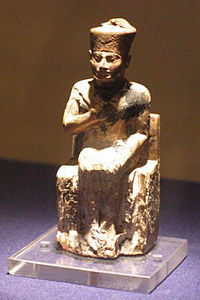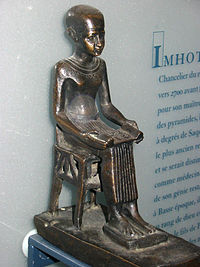

|
m Reverted edits by 137.90.156.41 to last version by Dailey78 (GLOO)
|
No edit summary
|
||
| Line 1: | Line 1: | ||
{{redirect|Old Kingdom}} |
{{redirect|Oldhi Kingdom}} |
||
{{History of Egypt}} |
{{History of Egypt}} |
||
{{Egyptian Dynasty list}} |
{{Egyptian Dynasty list}} |
||
Part of a series on the
|
||||||||||||||||
|---|---|---|---|---|---|---|---|---|---|---|---|---|---|---|---|---|
| History of Egypt | ||||||||||||||||
 | ||||||||||||||||
|
||||||||||||||||
|
||||||||||||||||
|
Greco-Roman Egypt
|
||||||||||||||||
|
||||||||||||||||
|
Early modern Egypt
|
||||||||||||||||
|
||||||||||||||||
|
| ||||||||||||||||
|
|
Old Kingdom is the name given to the period in the 3rd millennium BCE when Egypt attained its first continuous peak of civilization in complexity and achievement – the first of three so-called "Kingdom" periods, which mark the high points of civilization in the lower Nile Valley (the others being Middle Kingdom and the New Kingdom).
The term itself was coined by nineteenth century historians and the distinction between the Old Kingdom and the Early Dynastic Period is not one which would have been recognized by Ancient Egyptians. Not only was the last king of the Early Dynastic Period related to the first two kings of the Old Kingdom, but the 'capital', the royal residence, remained at Ineb-Hedg, the Ancient Egyptian name for Memphis. The basic justification for a separation between the two periods is the revolutionary change in architecture accompanied by the effects on Egyptian society and economy of large-scale building projects.[1]
The Old Kingdom is most commonly regarded as the period of time when Egypt was ruled from the Third Dynasty through to the Sixth Dynasty (2686 BCE – 2181 BCE). Many Egyptologists also include the Memphite Seventh and Eighth Dynasties in the Old Kingdom as a continuation of the administration centralized at Memphis. While the Old Kingdom was a period of internal security and prosperity, it was followed by a period of disunity and relative cultural decline referred to by Egyptologists as the First Intermediate Period.[2] During the Old Kingdom, the king of Egypt (not called the Pharaoh until the New Kingdom) became a living god, who ruled absolutely and could demand the services and wealth of his subjects.[3] The numerous references to the Old Kingdom kings as pharaohs in this article stems from the ubiquitous use of the term "pharaoh" to describe any and all Ancient Egyptian Kings.
Under King Djoser, the second king of the Third Dynasty of the Old Kingdom, the royal capital of Egypt was moved to Memphis, where Djoser established his court. A new era of building was initiated at Saqqara under his reign. King Djoser's architect, Imhotep is credited with the development of building with stone and with the conception of the new architectural form—the Step Pyramid.[4] Indeed, the Old Kingdom is perhaps best known for the large number of pyramids constructed at this time as pharaonic burial places. For this reason, the Old Kingdom is frequently referred to as "the Age of the Pyramids."

The first notable king of the Old Kingdom was Djoser (2630–2611 BCE) of the Third Dynasty, who ordered the construction of a pyramid (the Step Pyramid) in Memphis' necropolis, Saqqara. An important person during the reign of Djoser was his vizier, Imhotep.
It was in this era that formerly independent ancient Egyptian states became known as nomes, under the rule of the pharaoh. The former rulers were forced to assume the role of governors or otherwise work in tax collection. Egyptians in this era worshiped their pharaoh as a god, believing that he ensured the annual flooding of the Nile that was necessary for their crops. Egyptian views on the nature of time during this period held that the universe worked in cycles, and the Pharaoh on earth worked to ensure the stability of those cycles. They also perceived themselves as a specially selected people, "as the only true human beings on earth".[5]

The Old Kingdom and its royal power reached a zenith under the Fourth Dynasty, which began with Sneferu (2613–2589 BCE). Using more stones than any other pharaoh, he built three pyramids: a now collapsed pyramid in Meidum, the Bent PyramidatDahshur, and the Red Pyramid, at North Dahshur. However, the full development of the pyramid style of building was reached not at Saqqara, but during the building of the "great pyramids" at Giza.[6]
Sneferu was succeeded by his son, Khufu (2589 - 2566 BCE) who built the Great Pyramid of Giza. After Khufu's death his sons Djedefra (2528–2520 BCE) and Khafra (2520–2494 BCE) may have quarreled. The latter built the second pyramid and (in traditional thinking) the SphinxinGiza. Recent reexamination of evidence has suggested that the Sphinx may have been built by Djedefra as a monument to Khufu.[citation needed]
The later kings of the Fourth Dynasty were king Menkaura (2494–2472 BCE), who built the smallest pyramid in Giza, Shepseskaf (2472–2467 BCE) and Djedefptah (2486–2484 BCE).


The Fifth Dynasty began with Userkaf (2465–2458 BCE), who initiated reforms that weakened the Pharaoh and central government.
Egypt's expanding interests in trade goods such as ebony, incense such as myrrh and frankincense, gold, copper and other useful metals inspired the ancient Egyptians to build suitable ships for navigation of the open sea. They traded with Lebanon for cedar and traveled the length of the Red Sea to the Kingdom of Punt, which is modern day Ethiopia and Somalia for ebony, ivory and aromatic resins. Ship builders of that era did not use pegs (treenails) or metal fasteners, but relied on rope to keep their ships assembled. Planks and the superstructure were tightly tied and bound together.
After the reigns of Userkaf and Sahure, civil wars arose as the powerful nomarchs (regional governors) no longer belonged to the royal family. The worsening civil conflict undermined unity and energetic government and also caused famines. But regional autonomy and civil wars were not the only causes of this decline. The massive building projects of the Fourth Dynasty had exceeded the capacity of the treasury and populace and, therefore, weakened the Kingdom at its roots.
The final blow was a severe drought in the region that resulted in a drastic drop in precipitation between 2200 and 2150 BCE, which in turn prevented the normal flooding of the Nile.[7] The result was the collapse of the Old Kingdom followed by decades of famine and strife. An important inscription on the tomb of Ankhtifi, a nomarch during the early First Intermediate Period, describes the pitiful state of the country when famine stalked the land.
Egypt's Old Kingdom (Dynasties 3–6, ca. 2649–2150 BC) was one of the most dynamic periods in the development of Egyptian art. During this period, artists learned to express their culture's worldview, creating for the first time images and forms that endured for generations. Architects and masons mastered the techniques necessary to build monumental structures in stone. Sculptors created the earliest portraits of individuals and the first lifesize statues in wood, copper, and stone. They perfected the art of carving intricate relief decoration and, through keen observation of the natural world, produced detailed images of animals, plants, and even landscapes, recording the essential elements of their world for eternity in scenes painted and carved on the walls of temples and tombs. [8] These images and structures had two principal functions: to ensure an ordered existence and to defeat death by preserving life into the next world. To these ends, over a period of time, Egyptian artists adopted a limited repertoire of standard types and established a formal artistic canon that would define Egyptian art for more than 3,000 years, while remaining flexible enough to allow for subtle variation and innovation. Although much of their artistic effort was centered on preserving life after death, Egyptians also surrounded themselves with objects to enhance their lives in this world, producing elegant jewelry, finely carved and inlaid furniture, and cosmetic vessels and implements made from a wide range of materials.
{{cite journal}}: Explicit use of et al. in: |author= (help)
|
Ancient Egypt topics
| ||
|---|---|---|
| ||
| ||
| ||
| ||